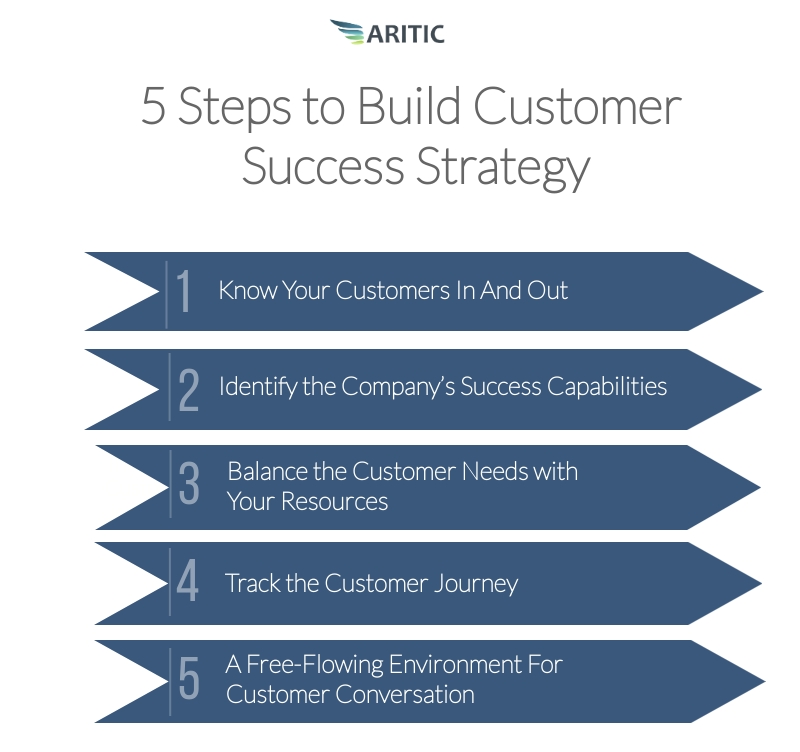We hear several new terminologies in the business world. One of the most recent buzzwords is Customer Success Strategy. People are continually sharing tips about how the industry can benefit from it.
Customer success strategy was initially limited to providing customer support or managing accounts.
Jump Directly to
1. Know Your Customers In And Out
2. Identify the Company’s Success Capabilities
3. Balance the Customer Needs with Your Resources
5. A Free-Flowing Environment For Customer Conversation
But now, the way you should interact with a customer has completely changed. The first thing towards a successful customer success strategy is a perfect plan of action that provides an impactful customer engagement solution.
I have listed some of the fundamental steps of customer success strategy below.

1. Know Your Customers In And Out
The first step towards any solution related to your customers is to identify your potential customer success team structure followed by their key business outcomes.
It is a dual-level process where at the enterprise level you need to understand the needs of your customer and how your product can help them achieve them.
Still Not an User of Aritic PinPoint Automation?
Hence, you need to define specific metrics for each of your business results and then link it to the corresponding ROI that your product will render relating to those key metrics.
However, the quest for a customer success saas strategy does not end here you need to identify the KPI’s and the essential elements that drive the user behavior.
User adoption is more about organizational performance than technical complexities. Understanding how customer organization perceives organizational changes is necessary to build a successful customer success plan.
2. Identify the Company’s Success Capabilities
Developing a successful marketing strategy does not happen in a day. If you are not able to match the customer’s success solution with organizational viability, then it can be disastrous. Share on XThe key metrics, approach, and goals of a company vary depending on its customer success SAAS capabilities.
From the very early CPR stage to complex stages of acquisition and growth all affect the key focal points of customer success strategy.
Irrespective of what you wish to focus on whether it is the net promoter score or dollar churn, the strategy you deploy will change according to the maturity scale of your organization.
3. Balance the Customer Needs with Your Resources
If you treat your entire customer base the same way and do not offer the personalized attention that they deserve, then you leave them unsatisfied. Sometimes you even lose your valuable customers.
Therefore your customer success plan must include categorizing your customers by revenue and other factors, and then deciding which type of service you should provide to which customer category.
Your services can range from services of automation to personalized services. It will help you retain your old customers and gain new ones.
The other thing is to analyze your functionality build-up and the chief components your company has deployed for a thriving customer success saas strategy. Does it lack any element that is important for a customer success strategy?
Do you build them or buy it from a third party?
4. Track the Customer Journey
You cannot measure the Customer success model on some pre-defined metrics like sales, pre-churn crisis moment, or acquisition. A comprehensive study traces the entire customer lifecycle.
Therefore, the fundamental points that need dedicated resources are customer onboarding, consulting, customer services, customer training, and renewals. A clear metric covering these points should be made available with well-defined hand-offs.
Thus your customers can quickly transit from one to the other.
5. A Free-Flowing Environment For Customer Conversation
Customer success SAAS is all about the seamless interchange of information between you and your customers. It is necessary that your customers have a proper platform to communicate and share their feedbacks.
As a result, feedback helps you to improve your working of plan and understand the touchpoints where you might be lagging.
How to Create an Effective Feedback Strategy?
Here are some steps to help you create an effective feedback strategy as part of building a customer success strategy:
- Determine Your Objectives: The first step is to define your objectives for collecting feedback. Identify what you want to achieve, such as understanding customer needs, identifying pain points, or improving customer satisfaction.
- Choose Your Feedback Methods: Identify the most appropriate feedback methods that align with your objectives. For example, surveys, polls, customer support interactions, and focus groups can provide valuable feedback.
- Develop Effective Questions: Create questions that are relevant to your objectives and easy for customers to understand and answer. Use clear and concise language and avoid leading questions.
- Identify the Right Audience: Determine the right audience to provide feedback. This can include new or existing customers, specific demographics, or customers at different stages of their journey.
- Analyze and Act on Feedback: Analyze the feedback you receive and identify patterns and themes to determine actionable insights. Use this feedback to address issues raised by customers, improve your products or services, and develop strategies to enhance customer satisfaction.
- Communicate Results and Next Steps: Share the results of the feedback with customers and show them how you plan to act on it. Be transparent about the steps you are taking to address their feedback and continually engage with customers to understand their evolving needs.
- Continuously Iterate: Finally, don’t stop at just one round of feedback collection. Continuously iterate your feedback strategy to ensure that it remains effective and relevant. Use feedback to drive product and service improvements and continuously enhance your customer success strategy.



10 Comments
Couldn’t have agreed more, these five steps are what a business needs to strive. Every customer is different from the other. Following the same pattern can seriously cost a company. Interacting with a customer and understanding and meeting their demands is the key for the road to success.
Successful marketing revolves around a customer’s journey. To be a successful organization you need to take into account some details regarding a successful customer strategy. These 5 steps are surely a good way to start.
If these 5 Steps to customer success strategy are implemented effectively, it will help you increase the conversion rate. Great work
Subhankar!
Great post. Great insights. I appreciate your efforts in collecting information, though successful marketing cannot take place without a customer.
As a marketer, I can understand the issues a customer faces; hence it’s important to understand customers and their pain points. Thanks a lot for updating information.
It was a great blog to read about customer success strategy. It includes a really nice study too!
Good work Subhankar! You have put great efforts in collecting information to build customer success strategy.
Great article on customer success strategy, thank you!
Great article. Thanks for sharing Shubhankar!
Have you ever wished you could have a routine for making the best of every customer you win? This strategy will help you implement a customer success strategy for your business so you can grow your customer lifetime value.